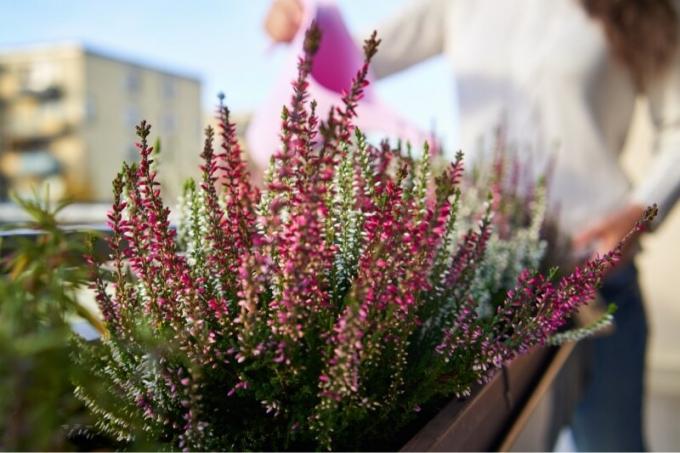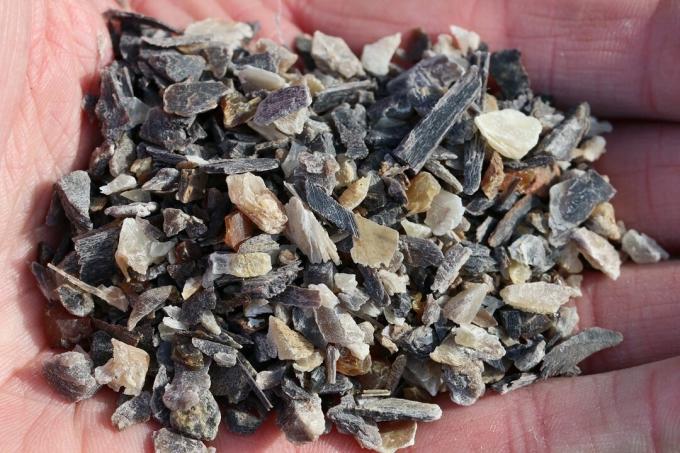
Heather comes in many different types and varieties. What they all have in common is that they are sensitive to too much or too little water. The result: the heather dries up. How to save your Erika.
In a nutshell
- Waterlogging is usually the cause of drying out
- leads to root rot, no more water absorption possible
- immediately transplant into fresh substrate
- Cut away rotten roots and dried plant parts
- Always do a finger test before watering
Table of contents
- Waterlogging most common cause
- save Erika
- Lack of water as the cause
- Proper care in winter
- frequently asked Questions
Waterlogging most common cause
As paradoxical as it may sound: If the heather gradually turns brown and dries up from below, Don't rule out too little water being the culprit - instead the plant is due to too much water "drowned". The plant cannot stand waterlogging at all, because this causes progressive waterlogging Root rot, which causes the plant to stop absorbing water through the rotting roots can.

You can tell from these symptoms whether your heather is actually waterlogged due to excessive watering:
- Soil feels damp or wet
- v. a. at a depth of several centimetres
- musty, unpleasant smell
- Plant dries up from below
- rotten, mushy or brown roots
If this applies to your heather plants, you should definitely stop watering them!
save Erika
To save Erika, stop the watering first. Furthermore, take these measures:
- pot or dig up
- carefully remove wet soil
- cut away rotten roots
- also withered parts of plants (do not turn green again)
- pot / plant in fresh substrate

Heath plants cultivated in pots in particular need good drainage, as this prevents waterlogging from the outset. For this you need
- a plant pot with a drainage hole
- a saucer or saucer
- as the bottom layer in the pot expanded clay or similar ä.
- loose substrate mixed with expanded clay or sand
Excess irrigation water runs through the pot and collects in the cachepot or in the bowl. coasters. Remove it promptly, i. H. within 10 to 15 minutes so that the plant does not get "wet feet". In the future, water only as needed, i.e. when the soil feels dry.
Tip: Water heather with if possible lime-poor water. Collected rainwater or stagnant, lukewarm tap water is good. Cooled potato cooking water can also be used for watering and provides additional nutrients.
Lack of water as the cause

Of course, it is also possible that the heather has dried up because it has not been watered - perhaps because you have been out for a few days and the days have been very hot. In this case, unpot the bucket Erika and place it with the root ball in a bucket of water. Let the plant soak up plenty of water, which can be easily recognized by the rising air bubbles. If these air bubbles are no longer visible, put the plant back in its pot.
A notice: In fact, caution is advised, especially on hot days, because heather needs a lot of water and should not dry out.
Proper care in winter

Source: H. cell, Erica carnea 001, Edited from Plantopedia, CC BY-SA 3.0
The so-called winter heather (Erica carnea) is a popular one Balcony planting for the cold season. However, this heather dries up particularly often - because too much is generally poured. Remember that plants need much less water in the winter than in the summer months. Therefore, before each planned watering, do a finger test:
- Stick your index finger several inches deep into the substrate.
- Does the soil feel damp?
- Then don't water.
- Is the earth dry?
- Then it has to be poured.
A notice: Here, too, good pot drainage is often life-saving.
frequently asked Questions
There is no concrete answer to this question, because the water requirement depends on many factors. Location, ambient temperature and soil moisture, among other things, determine how often and how much watering is required. The best way to determine the right time is with the finger test described above. Regarding the amount of water, it can be said that the soil should be moist after watering - but not wet. The water must not "stand" in the pot.
In fact, not every heather plant hardy. Above all, summer and heather (Calluna vulgaris), winter heath (Erica carnea) and the pretty Japanese lavender heather (Pieris japonica). heather (Erica cinerea) or the bell heather from South Africa (Erica gracilis) are not hardy here and therefore have to be planted anew every year. However, there are also hardy bell heathers with beautiful flowers, for example Erica tetralix (Moorheide) or Daboecia cantabrica (Irish bell heather).
The difference between summer and winter heather is quickly explained: summer heather is also known as broom heather and bears the scientific name Calluna vulgaris and flowers from August to October. The winter heather, on the other hand, is also called snow heather or winter-flowering heather because it blooms in the cold season between November and April. In addition Erica carnea, so the scientific name, evergreen.



